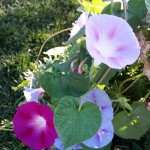 For most of my life, I’ve shrugged my shoulders when friends asked me non-edible growing questions. If ya couldn’t eat it, I just wasn’t that interested. Over the years, even my home’s landscaping utilized mostly edibles…sometimes a less than ideal game plan when living under the restrictive guidelines of a HOA as I did in my early 30’s. Just saying….
For most of my life, I’ve shrugged my shoulders when friends asked me non-edible growing questions. If ya couldn’t eat it, I just wasn’t that interested. Over the years, even my home’s landscaping utilized mostly edibles…sometimes a less than ideal game plan when living under the restrictive guidelines of a HOA as I did in my early 30’s. Just saying….
But in the last few years, I have enjoyed adding non edibles on the farm, and have in particular fallen in love with the humble morning glory. The photo left, features three varieties’ seeds tossed among a row of rosemary. Morning Glories are as easy to grow as radishes, and are a great canary in the cave if planted next to edibles because they show drought stress sooner than the edible plants we have them growing with. I’ve noticed that they’re reseeding each year, so at least here…we haven’t had to plant new seeds each year. They are annuals, rather than perennials which really was among the top reasons I didn’t discover them sooner. I’ve always thought that if I was going to grow a plant that provided no food, at least it should last more than a few months for all the work involved in getting it started. But Morning Glories slide by my Annual Non-edible Nuisance Factor Rule by not needing to be replanted each year. Which is kinda, sorta, like a perennial. And as they twine and reach over stumps and rock outcroppings, their beautiful assortment of colors, sizes, and shades continues to amaze me.
Not that I’m ever going to be a non-edible aficionado, but adding ground cover retains valuable moisture, and in the case of flowering plants, gives our growing bee colonies an option when the occasional week arrives and nothing edible is in bloom. Like cats, bees are cared for or suffer. Yes, bees can be feral, but die-off can be dramatic if a caring beekeeper isn’t keeping tabs on maintaining an easily accessible water source and making sure the hives actually have enough flowers to keep them well fed. One clue that our bees are struggling in the heat is when we see them congregating in every little puddle left behind after the irrigation has turned off. Uncool. We’re hoping to add a tiny water feature near the hives so that our bees don’t have to waste energy searching for water when it gets really hot out here.